George B. Berry Chair Professor of Engineering
Professor, Mechanical and Aerospace Engineering
Solid Oxide Fuel Cells
-
Chen, Y., Gerdes, K., Paredes Navia, S. A., Liang, L., Hinerman A., Song, X. (2019). Conformal Electrocatalytic Surface Nanoionics for Accelerating High-Temperature Electrochemical Reactions in Solid Oxide Fuel Cells, Nano Lett.
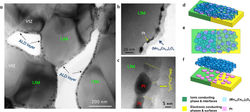 |
|---|
Additive implantation of electrocatalysts onto the internal surface of porous cathodes holds great promise to accelerate the electrochemical reactions within solid oxide fuel cells (SOFCs). Here we utilize atomic layer deposition (ALD) to apply dual catalysts with (Mn0.8Co0.2)3O4 and a minute amount of Pt on the cathode consisting of lanthanum strontium manganite (LSM) and yttria-stabilized zirconia (YSZ). Coating this material with optimum ALD layer thickness resulted in a 53% reduction of polarization resistance and a 350% SOFC peak power density enhancement at 750 °C. During the electrochemical operations, the dual catalysts interact synergistically and evolve into superjacent conformal electrocatalytic (Mn0.8Co0.2)3O4 nanoionics with high-density grain boundaries and subjacent discrete nano Pt particles evenly distributed on both the LSM and YSZ. The configuration consequently extends the active electrochemical reaction sites to the entire internal surface of the cathode. For the first time in the field of SOFCs, the present work demonstrates the formation of the electrocatalytic surface nanoionics and its resultant accelerated mass and charge transfer to dramatically boost the cell performance.
-
Wang, L.-C., Zhang, Y., Xu, J., Diao, W., Karakalos, S., Liu, B., Song, X., Wu, W., He, T., & Ding, D. (2019). Non-oxidative Dehydrogenation of Ethane to Ethylene over ZSM-5 Zeolite Supported Iron Catalysts. Applied Catalysis B: Environmental, 117816.
 |
|---|
The shale gas boom has stimulated tremendous interests in ethylene production using ethane as the feedstock. Catalytic non-oxidative ethane dehydrogenation (EDH) to ethylene represents a viable strategy to improve the process energy efficiency and to minimize the environmental impact. The breakthroughs in catalyst design play a key role in the successful development of this process. Herein, we demonstrate that iron supported on ZSM-5 zeolite (Fe/ZSM-5) is a highly efficient catalyst for the EDH reaction. Under comparable conditions, Fe/ZSM-5 exhibits superior activity and stability over various metal (Pt) or metal oxide catalysts (Zn, Ga, Cr, Mo) supported on ZSM-5. The use of ZSM-5 instead of conventional γ-Al2O3 as the support for Fe catalysts is critical to achieve high activity and selectivity in the EDH reaction. Detailed structure characterizations combined with density functional calculations indicate that iron oxides in the as-prepared Fe/ZSM-5 catalysts are reduced to iron metal and then carburized under reaction condition, which accounts for the excellent activity and stability for the EDH reaction. Compared with Fe/Al2O3, the relatively weaker binding strength of ethylene and the weaker surface acidity on Fe/ZSM-5 allow facile desorption of ethylene, which suppresses its consecutive transformation into higher hydrocarbons and carbon deposits, resulting in higher ethylene selectivity.
-
Chen, Y., Liang, L., Paredes Navia, S., Hinerman, A., Gerdes, K., & Song, X. (2019). Synergetic Interaction of Additive Dual Nano Catalysts to Accelerate Oxygen Reduction Reaction in Fuel Cells Cathode. Acs Catalysis.
 |
|---|
The sluggish oxygen reduction reaction (ORR) in the cathode is hindering the power density of solid oxide fuel cells (SOFCs). Infiltration of catalyst into the cathode of SOFCs is promising to accelerate the ORR. However, the degradation associated with the coarsening of the nanocatalyst is intense. To stabilize the catalyst, atomic layer deposition (ALD) is employed to coat a dual electrocatalyst consisting of a superjacent 2 nm CoOx layer and superjacent 3 nm discrete Pt particles into the porous lanthanum strontium manganite (LSM)/yttria-stabilized zirconia (YSZ) cathode. After 504 h of operation at 750 °C, the ALD coating resulted in the peak power density enhancement by ∼200%, while CoO x becomes Mn-enriched (MnCo)Ox nanograins coupling with nano-Pt. The Pt/(MnCo)Ox nanocouplings are uniformly distributed on the YSZ grain surface, triple-phase boundaries, and at LSM/LSM surface grain boundaries. This study demonstrates an effective approach of stabilizing the minute amount of catalyst for enhancing ORR activity at elevated temperatures.
-
Chen, Y., Fan, Y., Lee, S., Hackett, G., Abernathy, H., Gerdes, K., & Song, X. (2019). Interface and grain boundary degradation in LSM-YSZ composite Solid Oxide Fuel Cell cathodes operated in humidified air. Journal of Power Sources, 438, 227043. doi:https://doi.org/10.1016/j.jpowsour.2019.227043
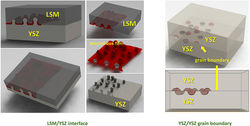 |  |
|---|
The interfaces between the different phases and the associated triple phase boundaries (TPBs) in solid oxide fuel cell (SOFC) cathodes are critical for the oxygen reduction reaction, and their degradation impacts SOFC performance and durability. This work examines nanostructure degradation of composite LSM/YSZ cathodes induced by electrochemical operation in humidified air. Three commercial button cells operated in humidified air for various durations at 800 °C exhibited more severe performance degradation than the cell operated in dry air. Microscopy imaging reveals nanostructure degradation within the cathode active layer, especially in the regions nearest to the electrolyte. Newly formed Mn-enriched nano-precipitates accompanied by nano-voids initiate at the original TPBs and propagate along the LSM/YSZ interface. The abundance of the nano-precipitates at LSM/YSZ interfaces increases with operation time, and prolonged operation in humidified air further promotes the formation of the Mn-enriched precipitates along YSZ/YSZ grain boundaries. The formation mechanism of those precipitates and their influence on the cathode performance are discussed.
-
Chen, Y., Hinerman, A., Liang, L., Gerdes, K., Navia, S. P., Prucz, J., & Song, X. (2018). Conformal coating of cobalt oxide on solid oxide fuel cell cathode and resultant continuously increased oxygen reduction reaction kinetics upon operation. Journal of Power Sources, 405, 45-50. doi:https://doi.org/10.1016/j.jpowsour.2018.10.022
 |  |
|---|
To improve the sluggish oxygen reduction reaction from the cathode of solid oxide fuel cells (SOFCs), a conformal layer of catalytic CoOx grains was deposited onto the internal surface of LSM/YSZ composite cathode of commercial cells, through atomic layer deposition (ALD). Upon the electrochemical operation, the ALD coated cell has dramatic reduction of the polarization resistance, and the power density exhibits continuous increase over the course of 172 h operation at 750 °C and reaches the cell performance enhancement by a factor of 1.6, in comparison with that from the baseline operated for 96 h. Such performance enhancement was attributed to the combination of the newly added triple phase boundaries for promoting the oxygen reduction reaction, as well as the accelerated oxygen transport on the cathode surface. The present work opens the further research direction for ALD coating of non-precious metal catalyst to boost the performance of as-fabricated SOFCs.
-
Chen, Y., Gerdes, K., & Song, X. (2016). Nanoionics and Nanocatalysts: Conformal Mesoporous Surface Scaffold for Cathode of Solid Oxide Fuel Cells. Scientific Reports, 6, 32997. doi:10.1038/srep32997
 |  |
|---|---|
 |
Nanoionics has become increasingly important in devices and systems related to energy conversion and storage. Nevertheless, nanoionics and nanostructured electrodes development has been challenging for solid oxide fuel cells (SOFCs) owing to many reasons including poor stability of the nanocrystals during fabrication of SOFCs at elevated temperatures. In this study, a conformal mesoporous ZrO2 nanoionic network was formed on the surface of La1−xSrxMnO3/yttria-stabilized zirconia (LSM/YSZ) cathode backbone using Atomic Layer Deposition (ALD) and thermal treatment. The surface layer nanoionic network possesses open mesopores for gas penetration, and features a high density of grain boundaries for enhanced ion-transport. The mesoporous nanoionic network is remarkably stable and retains the same morphology after electrochemical operation at high temperatures of 650–800 °C for 400 hours. The stable mesoporous ZrO2 nanoionic network is further utilized to anchor catalytic Pt nanocrystals and create a nanocomposite that is stable at elevated temperatures. The power density of the ALD modified and inherently functional commercial cells exhibited enhancement by a factor of 1.5–1.7 operated at 0.8 V at 750 °C.
-
Song, X., Lee, S., Chen, Y., & Gerdes, K. (2015). Electrochemically influenced cation inter-diffusion and Co3O4 formation on La0.6Sr0.4CoO3 infiltrated into SOFC cathodes. Solid State Ionics, 278, 91-97. doi:http://dx.doi.org/10.1016/j.ssi.2015.05.026
 |  |
|---|
Nanosized LSC electrocatalyst was infiltrated into a porous scaffold cathode composed of Sm2O3-doped CeO2 (SDC) and La0.6Sr0.4Co0.2Fe0.8O3-δ (LSCF) in a commercial button solid oxide fuel cell (SOFC). To understand the stability of cathodes infiltrated with LSC, the infiltrated composite cells were subjected to both electrochemical operating and thermal aging states at 750 °C for 1500 h. Nanostructure and local chemistry evolution of La0.6Sr0.4CoO3 (LSC) infiltrated cathodes upon operation and aging were investigated by transmission electron microscopy. After operation, the LSC remained a cubic perovskite, and the crystal grains exhibit comparable size to as-infiltrated LSC grains. Inter-diffusion of Fe from the LSCF to a Fe-incorporated LSC layer developed on the LSCF backbone. However, only sharp interfaces were observed between LSC and SDC backbone in the as-infiltrated cathode and such interfaces remain after operation. The infiltrated LSC on the SDC backbone also retains granular particle morphology. Furthermore, newly grown Co3O4 nanocrystals were found in the operated cathode. After thermal aging, on the other hand, cation inter-diffusion across the interfaces of the infiltrate particles and the cathode backbones is less than that from the operated cells. The following hypothesis is proposed: Co3O4 forms on LSC arising from local charge balancing between cobalt and oxygen vacancies.
-
Hackett, G. A., Gerdes, K., Chen, Y., Song, X., & Zondlo, J. (2015). Performance Impact Associated with Ni-Based SOFCs Fueled with Higher Hydrocarbon-Doped Coal Syngas. Metallurgical and Materials Transactions E, 2 (1), 58-69. doi:10.1007/s40553-015-0044-y
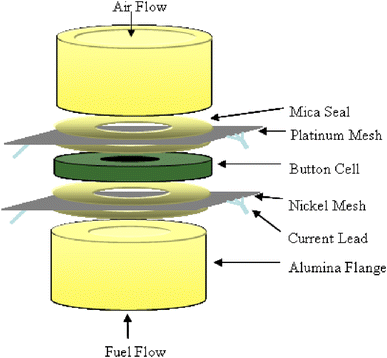 | 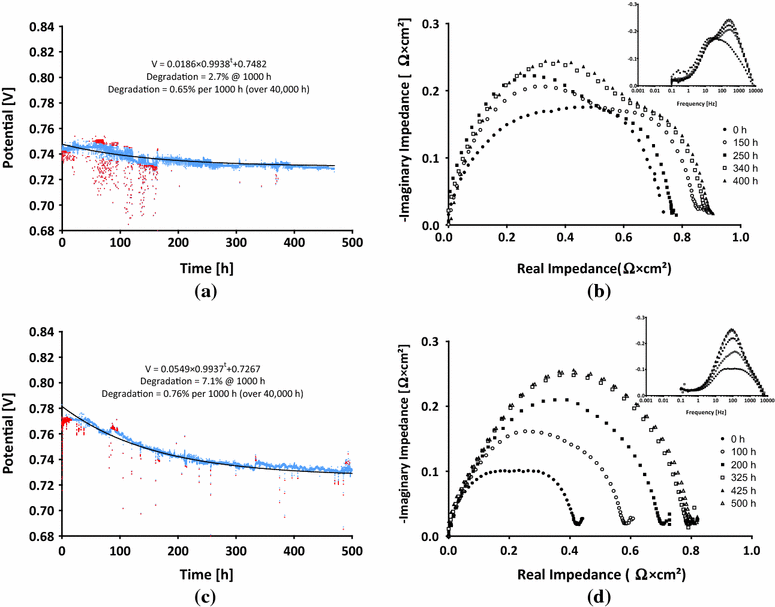 |
|---|
Energy generation strategies demonstrating high efficiency and fuel flexibility are desirable in the contemporary energy market. When integrated with a gasification process, a solid oxide fuel cell (SOFC) can produce electricity at efficiencies exceeding 50 pct by consuming fuels such as coal, biomass, municipal solid waste, or other opportunity wastes. The synthesis gas derived from such fuel may contain trace species (including arsenic, lead, cadmium, mercury, phosphorus, sulfur, and tars) and low concentration organic species that adversely affect the SOFC performance. This work demonstrates the impact of exposure of the hydrocarbons ethylene, benzene, and naphthalene at various concentrations. The cell performance degradation rate is determined for tests exceeding 500 hours at 1073 K (800 °C). Cell performance is evaluated during operation with electrochemical impedance spectroscopy, and exposed samples are post-operationally analyzed by scanning electron microscopy/energy dispersive spectroscopy, X-ray photoelectron spectroscopy, and transmission electron microscopy. The short-term performance is modeled to predict performances to the desired 40,000-hours operational lifetime for SOFCs. Possible hydrocarbon interactions with the nickel anode are postulated, and acceptable hydrocarbon exposure limits are discussed.
-
Abernathy, H., Finklea, H. O., Mebane, D. S., Song, X., Chen, Y., & Gerdes, K. (2015). Examination of the mechanism for the reversible aging behavior at open circuit when changing the operating temperature of (La0.8Sr0.2)0.95MnO3 electrodes. Solid State Ionics, 272 (0), 144-154. doi:http://dx.doi.org/10.1016/j.ssi.2015.01.013
 |  |
|---|
The aging behavior of symmetrical cells, consisting of either (La0.8Sr0.2)0.95MnO3 (LSM) or La0.6Sr0.4Co0.2Fe0.8O3 (LSCF) electrodes screen printed on either 8 mol% yttria-stabilized zirconia (YSZ) or Ce0.8Gd0.2O2 (GDC) electrolyte substrates, is reported as the symmetrical cell is thermally cycled between 700 °C and 800 °C. For LSM, between 700 °C and 850 °C, the polarization resistance exhibits slow increases or decreases with time (on the order of days) after a quick change in temperature. When increasing the temperature, the polarization resistance decreases with time, and when decreasing the temperature, the polarization resistance slowly increases with time. In a previous work, the authors had explained these results with LSM by connecting the testing conditions to literature reports of surface analysis of LSM thin films which demonstrated a change in the amount of surface cation segregation as a function of temperature. In this work, TEM/EDS/XPS analysis of dense LSM pellets thermally cycled under the same conditions as the symmetrical cells does not indicate any significant reversible change in the surface composition of the LSM pellet between 700 °C and 800 °C. An alternative hypothesis is proposed to explain the relationship between polarization resistance and the LSM cation/anion vacancy concentrations controlled by the Schottky reaction. The timescale of aging behavior is related to the time necessary for the cations to move to or from the LSM surface to adjust to the new equilibrium at each temperature. The relevance in understanding the mechanism behind the aging behavior is emphasized with respect to fuel cell sample/stack modeling as well as to proper testing procedures for reaching reliable conclusions when comparing different electrode samples.
-
Gong, Y., Patel, R. L., Liang, X., Palacio, D., Song, X., Goodenough, J. B., & Huang, K. (2013). Atomic layer deposition functionalized composite SOFC cathode La0.6Sr0.4Fe0.8Co0.2O3-δ-Gd0.2Ce0.8O1.9: Enhanced long-term stability. Chemistry of Materials, 25 (21), 4224-4231.
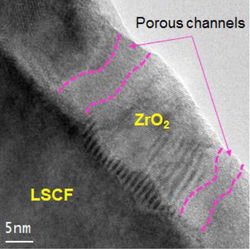 | 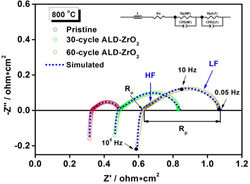 |
|---|
We report that the long-term stability of a conventional mixed oxide-ion and electron conducting solid oxide fuel cell cathode, La0.6Sr0.4Fe0.8Co0.2O3−δ-Gd0.2Ce0.8O1.9 (LSCF-GDC) composite, can be markedly improved by functionalizing its surfaces with a conformal layer of nanoscale ZrO2 films through atomic layer deposition (ALD). Over a >1100 h testing at 800 °C, the overcoated LSCF-GDC cathode exhibited respective polarization and ohmic area-specific-resistances 3 and 1.5 times lower than the pristine sample, whereas the pristine LSCF-GDC cathode degraded at a rate 4 times faster than the overcoated one. The multifunctionality of porosity, mixed conductivity, and suppressed Sr-enrichment enabled by the nanoscaled ALD-ZrO2 overcoats are attributed to the performance retention observed for the overcoated cathode.
-
Gong, Y., Palacio, D., Song, X., Patel, R. L., Liang, X., Zhao, X., Goodenough, J. B., Huang, K. (2013). Stabilizing Nanostructured Solid Oxide Fuel Cell Cathode with Atomic Layer Deposition. Nano Letters, 13 (9), 4340-4345. doi:10.1021/nl402138w
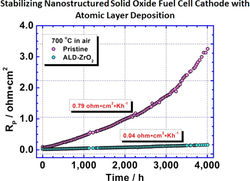 | 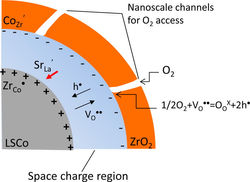 |
|---|
We demonstrate that the highly active but unstable nanostructured intermediate-temperature solid oxide fuel cell cathode, La0.6Sr0.4CoO3-δ (LSCo), can retain its high oxygen reduction reaction (ORR) activity with exceptional stability for 4000 h at 700 °C by overcoating its surfaces with a conformal layer of nanoscale ZrO2 films through atomic layer deposition (ALD). The benefits from the presence of the nanoscale ALD-ZrO2 overcoats are remarkable: a factor of 19 and 18 reduction in polarization area-specific resistance and degradation rate over the pristine sample, respectively. The unique multifunctionality of the ALD-derived nanoscaled ZrO2 overcoats, that is, possessing porosity for O2 access to LSCo, conducting both electrons and oxide-ions, confining thermal growth of LSCo nanoparticles, and suppressing surface Sr-segregation is deemed the key enabler for the observed stable and active nanostructured cathode.
-
Hackett, G. A., Gerdes, K., Song, X., Chen, Y., Shutthanandan, V., Engelhard, M., Zhu Z., Thevuthasan, S., Gemmen, R. (2012). Performance of solid oxide fuel cells operated with coal syngas provided directly from a gasification process. Journal of Power Sources, 214 (0), 142-152. doi:http://dx.doi.org/10.1016/j.jpowsour.2012.04.050
 |
|---|
Solid oxide fuel cells (SOFCs) are being developed for integrated gasification power plants that generate electricity from coal at 50+% efficiency. The interaction of trace metals in coal syngas with Ni-based SOFC anodes is being investigated through thermodynamic analyses and in laboratory experiments, but test data from direct coal syngas exposure are sparsely available. This effort evaluates the significance of performance losses associated with exposure to direct coal syngas. Specimen are operated in a unique mobile test skid that is deployed to the research gasifier at NCCC in Wilsonville, AL. The test skid interfaces with a gasifier slipstream to deliver hot syngas to a parallel array of twelve SOFCs. During the 500 h test period, all twelve cells are monitored for performance at four current densities. Degradation is attributed to syngas exposure and trace material attack on the anode structure that is accelerated at increasing current densities. Cells that are operated at 0 and 125 mA cm −2 degrade at 9.1 and 10.7% per 1000 h, respectively, while cells operated at 250 and 375 mA cm −2 degrade at 18.9 and 16.2% per 1000 h, respectively. Spectroscopic analysis of the anodes showed carbon, sulfur, and phosphorus deposits; no secondary Ni-metal phases were found.
-
Chen, S., Chen, Y., Finklea, H., Song, X., Hackett, G., & Gerdes, K. (2012). Crystal defects of yttria stabilized zirconia in Solid Oxide Fuel Cells and their evolution upon cell operation. Solid State Ionics, 206 (0), 104-111. doi:10.1016/j.ssi.2011.11.008
 |
|---|
Solid oxide fuel cell (SOFC) electrolytes must be crystallographically and chemically stable in typical operating environments, while also possessing high ionic and low electronic conductivities. Cubic fluorite structured yttria-stabilized zirconia (YSZ), in which ion conduction is provided by oxide ion vacancies, is a proven oxide ion conductor fulfilling such requirements. In the present work, the microstructural and crystallographic defects of YSZ in the anode (Ni/YSZ), cathode (LSM/YSZ), and electrolyte of commercial SOFC cells were studied using Transmission Electron Microscopy (TEM). Comparisons were made between an as-received cell and a cell operated at 800 °C for 550 h using syngas as fuel. Examination of the YSZ electron diffraction pattern of the cathode reveals a typical cubic fluorite crystal structure. However, weak diffraction spots, where diffractions should be absent according to the structure factor of the cubic fluorite phase, are present in the patterns taken from the YSZ in the anode and the electrolyte. The appearance of kinematically forbidden spots in YSZ is unchanged after cell operation. Such weak diffraction spots can be interpreted as arising from a nanoscale (2–10 nm) irregularly-shaped tetragonal YSZ ( t-YSZ) domain that is randomly distributed in the cubic YSZ ( c-YSZ) matrix. However, larger t-YSZ domains with thicknesses of 5–10 nm and lengths of 30 nm are observed by the Ni/YSZ interfaces in cells operated at 800 °C in coal-derived syngas for 550 h. The layered t-YSZ domains are accompanied by the c-YSZ domains, implying the migration of Y along the Ni/YSZ interface in response to cell operation.
-
Chen, Y., Chen, S., Hackett, G., Finklea, H., Song, X., & Gerdes, K. (2011). Microstructural and chemical evolution near anode triple phase boundary in Ni/YSZ solid oxide fuel cells. Solid State Ionics, 204–205 (0), 87-90. doi:10.1016/j.ssi.2011.10.005
 |
|---|
In this study, we report the micro-structural and chemical evolution of anode grain boundaries and triple phase boundary (TPB) junctions of Ni/YSZ anode supported solid oxide fuel cells. A NiO phase was found to develop along the Ni/YSZ interfaces extending to TPBs in the operated cells. The thickness of the NiO ribbon phase remains constant at ~ 5 nm in hydrogen for operating durations up to 540 h. When operating on synthesis gas, an increase in interphase thickness was observed from ~ 11 nm for 24 h of operation to ~ 51 nm for 550 h of operation. YSZ phases are observed to be stable in H 2 over 540 h of operation. However, for the cell operated in syngas for 550 h, a 5–10 nm tetragonal YSZ ( t-YSZ) interfacial layer was identified that originated from the Ni/YSZ interfaces. Yttrium species seem to segregate to the interfaces during operation, leading to the formation of t-YSZ in the Y-depleted regions.
-
Chen, Y., Chen, S., Hackett, G., Finklea, H., Zondlo, J., Celik, I., Song, X., Gerdes, K. (2013). Microstructure degradation of YSZ in Ni/YSZ anodes of SOFC operated in phosphine-containing fuels, Solid State Ionics, 234, 25-32.
 |
|---|
The interaction of trace (ppm) phosphine with the nickel/yttria stabilized zirconia (YSZ) anode of commercial solid oxide fuel cells has been investigated and evaluated for both synthesis gas and hydrogen fuels in an effort to examine P–Y reactions. The Ni poisoning effects reported in literature were confirmed and degradation was examined by electrochemical methods and post-test microstructural and chemical analyses. The results indicate that P-induced degradation rates and mechanisms are fuel dependent and that degradation of cells operated in synthesis gas (syngas) with phosphine is more severe than that of cells operated in hydrogen with phosphine. As reported in published literature, a cell operated in syngas containing 10 ppm phosphine demonstrated significant microstructural degradation within the Ni phase, including formation of Ni–P phases concentrated on the outer layer of the anode and significant pitting corrosion in the Ni grains. In this research, a previously undetected YPO4 phase is observed at the YSZ/YSZ/Ni triple grain junctions located at the interface with the YSZ electrolyte. Tetragonal YSZ ( t-YSZ) and cubic-YSZ ( c-YSZ) domains with sizes of several tens of nanometers are also newly observed along the Ni/YSZ interface. These observations contrast with data obtained for a cell operated in dry hydrogen with phosphine, where no YPO4 phase is observed and the alternating t-YSZ and c-YSZ domains at the Ni/YSZ interface are smaller with typical sizes of 5–10 nm. The data imply that electrolyte attack by P is a potentially debilitating mode of degradation in SOFC anodes, and that the associated reaction mechanisms and rates are worthy of further examination.